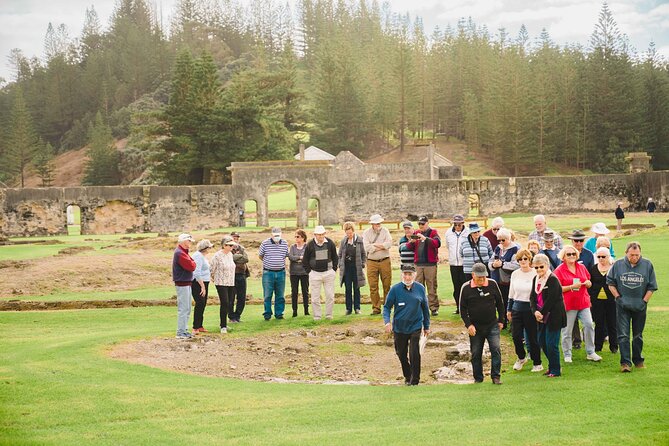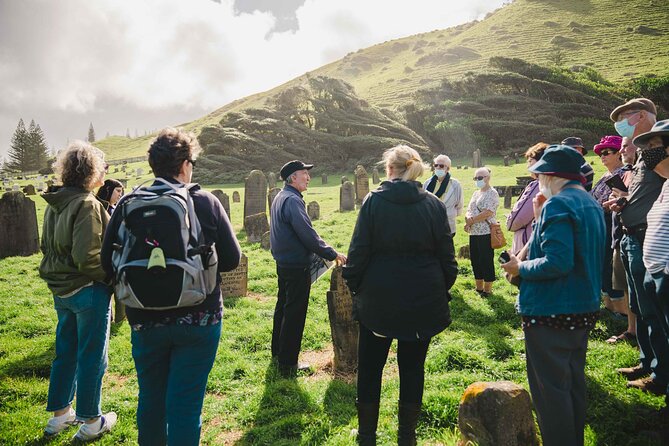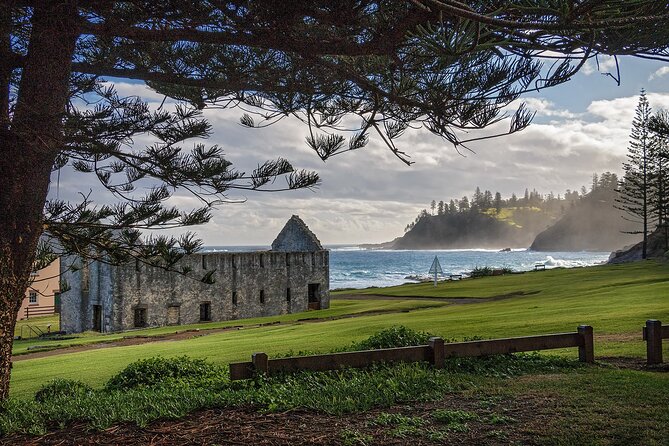Embark on an enthralling expedition through time with the Convict Settlement Tour on Norfolk Island. This captivating journey allows visitors to enjoy the island’s intriguing history, uncovering the tales of Polynesian settlers, convicts, and Pitcairn Islanders.
Led by knowledgeable guides, you will traverse the UNESCO-listed Kingston and Arthurs Vale Historic Area, where the remnants of the past come alive. From the solemn colonial headstones in the island cemetery to the haunting ruins of the New Gaol, each stop offers a glimpse into the lives and struggles of those who once called Norfolk Island home.
With a range of inclusions and convenient meeting options, this tour promises an experience that will leave you yearning for more.
Good To Know

- Kingston and Arthurs Vale Historic Area offers a captivating journey through time, immersing visitors in the rich tapestry of Polynesian, convict, and Pitcairn Islander history.
- Norfolk Island is a UNESCO-Listed Living Showcase, showcasing the intertwined histories of Polynesians, convicts, and Pitcairn Islanders through language, music, dance, historic buildings, and ruins.
- The Island Cemetery Colonial Headstones hold historical significance, telling the stories of those who lived and died on the island and preserving the memories and heritage of Norfolk Island.
- The Ruins of the New Gaol serve as a haunting testament to the island’s dark past, reminding visitors of the harsh realities of convict life and raising questions about the debate between punishment and rehabilitation.
Kingston and Arthurs Vale Historic Area

Located within the Norfolk Island Convict Settlement Tour, the Kingston and Arthurs Vale Historic Area offers visitors a captivating journey through time, immersing them in the rich tapestry of Polynesian, convict, and Pitcairn Islander history.
Kingston, the capital of Norfolk Island, holds great historical significance as the site of a former penal colony and later as the administrative center of the island. The area showcases the remnants of the island’s past, including the ruins of the New Gaol (jail), colonial headstones in the island cemetery, and the old homes on Quality Row.
Arthurs Vale, on the other hand, played a vital role in the island’s development, serving as a farming and industrial hub. Exploring this area allows visitors to gain a deeper understanding of Kingston’s history and appreciate the significance of Arthurs Vale in shaping the island’s identity.
Find more activities and experiences we've covered in Norfolk Island.
Unesco-Listed Living Showcase
The UNESCO-listed living showcase of Norfolk Island is a captivating testament to the intertwined histories of Polynesians, convicts, and Pitcairn Islanders. This beautiful island in the South Pacific Ocean isn’t only known for its stunning landscapes and pristine beaches but also for its rich cultural heritage.
Here are three highlights of the UNESCO-listed living showcase:
Polynesian Influence: Norfolk Island has a strong Polynesian influence, which is evident in its language, music, and dance. Visitors can enjoy the vibrant Polynesian culture through traditional performances and workshops.
Convict History: As a former convict settlement, Norfolk Island is steeped in history. The island’s historic buildings, such as the ruins of the New Gaol and the old homes on Quality Row, offer a glimpse into the harsh realities faced by convicts during the colonial era.
Pitcairn Islander History: Norfolk Island also has strong ties to the Pitcairn Islanders, descendants of the mutineers from the HMS Bounty. Visitors can learn about their unique history and culture through guided tours and interactions with the local community.
Exploring the UNESCO-listed living showcase of Norfolk Island is a truly immersive experience that brings the island’s fascinating history to life.
Island Cemetery Colonial Headstones

As visitors delve deeper into the captivating UNESCO-listed living showcase of Norfolk Island, they are transported to the island cemetery, where a unique collection of colonial headstones tells the stories of those who lived and died during its tumultuous history. The island cemetery holds great historical significance, serving as a testament to the island’s past as a convict settlement. These colonial headstones, standing tall amidst the serene surroundings, are a poignant reminder of the lives that were once lived on this remote island. Each headstone tells its own tale, with inscriptions that offer glimpses into the struggles, triumphs, and tragedies of the individuals buried beneath. The cultural preservation of these headstones is of utmost importance, as they serve as a tangible link to Norfolk Island’s past, preserving the memories and heritage of those who came before.
| Column 1 | Column 2 |
|---|---|
| Names of the deceased | Inscriptions on stones |
| John Smith | "Here lies a devoted father and loving husband" |
| Mary Johnson | "In loving memory of a dear sister and friend" |
| William Thompson | "Gone but never forgotten, forever in our hearts" |
| Elizabeth Brown | "Rest in peace, beloved daughter and sister" |
| James Wilson | "A life well-lived, now at eternal rest" |
Ruins of the New Gaol

Tucked away amidst the captivating landscape of Norfolk Island, the Ruins of the New Gaol stand as a haunting testament to the island’s dark past.
The prison, built in the mid-1800s, was designed with a unique prison architecture that aimed to instill fear and punishment in the hearts of the prisoners. The gaol consisted of three main parts: the cell block, the punishment yard, and the exercise yard.
Inside the cell block, prisoners were subjected to cramped and squalid conditions. The punishment yard housed instruments of torture such as whipping posts and stocks. The exercise yard, on the other hand, allowed inmates limited outdoor time.
The ruins serve as a reminder of the harsh realities of convict life and the ongoing debate between punishment and rehabilitation.
Old Homes on Quality Row

Nestled along Quality Row, a collection of charming old homes awaits visitors on Norfolk Island. These historic houses hold great historical significance and showcase remarkable architectural features.
As you stroll along the row, you can’t help but be captivated by the stories that these homes hold within their walls. Each house has its own unique style, reflecting the era in which it was built. From Georgian to Victorian, you’ll find a variety of architectural influences that transport you back in time.
The attention to detail in the craftsmanship is evident, with intricate woodwork, ornate facades, and beautifully preserved interiors. Exploring these old homes is like stepping into a living museum, providing a glimpse into the island’s rich past and the lives of its inhabitants.
Inclusions and Meeting Details
The tour of the Norfolk Island Convict Settlement includes a range of inclusions and detailed meeting information to ensure a seamless and informative experience for visitors.
The tour offers tea and a professional guide to enhance the journey through history.
Guests have the option to directly head to the meeting point or request pickup from their accommodations in the general Burnt Pine Town Area.
The meeting point is located at the Tax store Norfolk Island, and pickup is available from hotels and motels in the area.
For guests staying further out of town, there’s a loading area located at 68A Taylors Road. It’s important to provide accommodation details when booking.
The tour also has a flexible cancellation policy and offers alternative dates or a full refund in case of poor weather.
Common Questions
How Long Does the Convict Settlement Tour on Norfolk Island Typically Last?
The duration of the convict settlement tour on Norfolk Island typically lasts around 2 hours. There are no age restrictions for the tour, making it suitable for all visitors interested in exploring the island’s rich historical past.
Are Children Allowed to Participate in the Convict Settlement Tour?
Yes, children are allowed to participate in the Convict Settlement Tour on Norfolk Island. It offers family-friendly activities, allowing kids to learn about the island’s history while exploring places like Kingston and the Arthurs Vale Historic Area.
Can I Bring Food or Drinks on the Tour?
Yes, guests are allowed to bring their own food and drinks on the Convict Settlement Tour. However, please be mindful of any photography restrictions that may be in place during certain parts of the tour.
Is There a Dress Code for the Tour?
There is no strict dress code for the tour, but it is recommended to wear comfortable clothing and shoes. Guests are also advised to check if there are any photography restrictions in certain areas.
What Is the Maximum Group Size for the Convict Settlement Tour?
The maximum group size for the Convict Settlement Tour on Norfolk Island is not specified. However, it is advisable to check with the tour provider regarding any age restrictions or limitations before making a booking.
The Sum Up
Enjoy the captivating history of Norfolk Island with the Convict Settlement Tour.
Explore the UNESCO-listed Kingston and Arthurs Vale Historic Area, where the intertwined stories of Polynesian settlers, convicts, and Pitcairn Islanders come to life.
From the poignant colonial headstones in the island cemetery to the haunting ruins of the New Gaol, this tour offers a unique glimpse into the past.
With convenient meeting options and a flexible cancellation policy, this immersive journey isn’t to be missed.
More Tours in Norfolk Island
More Tour Reviews in Norfolk Island
Looking for something different? Other Norfolk Island activities we've written about
- 9 Best Tours In Norfolk Island
- Colleen McCullough Home Tour On Norfolk Island
- Omakase Chefs Demo Shared Experience
- 8 Days Drive / Stay / Tour in Norfolk Island
- Who Killed the Surveyor Mystery Dinner
- Baunti Fish Fry Tour With Hotel Transfers
- Two-Hour Food-Focused Tour of Norfolk Island
- 1856 The Untold Story
- Island Orientation Tour With Airport Transfer Norfolk Island
- Breakfast Bushwalk in Norfolk Island
- Island Orientation Package Incl. Return Airport Transfers & Tour
